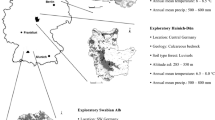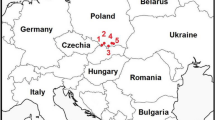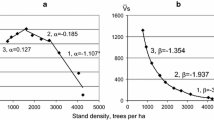Abstract
We simulated the self-thinning of Rhizophora mangle mangrove forests with the spatially explicit simulation model KiWi. This model is an application of the field-of-neighbourhood (FON) approach, which describes an individual tree by a competition function defined on the zone of influence (ZOI) around the stem. The FON causes growth depression of the trees involved. Sustained growth depression results in tree death. We propose a subdivision of the biomass density trajectories (bdt), obtained during the thinning process, into four segments related to characteristic shapes of the stem diameter distribution of the cohort. A positive skewness of the stem diameter distribution, indicating that the majority of the individuals are small and hindered in growth, is necessary for the occurrence of a linear segment within the bdt, the so-called 'self-thinning line'. This segment is the third bdt segment according to our classification. It is reached when the positive skewness of the stem diameter distribution is maximal and ends when the skewness reaches its second zero transition. The thinning line is therefore linked to the homogenisation process, which forces the symmetry of the stem distribution. We show that the ongoing search for a universal slope for the linear segment of the biomass-density trajectory (bdt) cannot succeed, since it is species-specific and may also be site-dependent. The slope increases with increasing competition strength of the individuals. Nevertheless, the lower limit of the slope is pre-defined by geometrical constraints and modified by the actual strength of the neighbourhood competition. Although the simulations were all carried out with growth parameters of the mangrove species Rhizophora mangle, our results should be qualitatively valid and form a plausible theoretical framework to account for different biomass-density trajectories.
Similar content being viewed by others
References
Adler F.R. 1996. A model of self-thinning through local competition. Proceedings National Academy of Science USA 93: 9980–9984.
Bauer S., Berger U., Hildenbrandt H., Eisinger D. and Grimm V. 2001. Modellierung von Nachbarschaftskonkurrenz in Pflanzenpopulationen: Test eines neuen Ansatzes. In: Jopp F. and Weigmann G. (eds), Theorie in der Ökologie – Band 3. Peter Lang, Frankfurt/M, pp. 31–42.
Bauer S., W yszomirski T., Berger U., Hildenbrandt H. and Grimm V. 2002. Asymmetric competition as natural outcome of neighbour interactions among plants: results from the field-of-neighbourhood modelling approach. Plant Ecology (in press).
Begon M., Harper J.L. and Townsend C.R. 1991. Ökologie: Individuen, Populationen und Lebensgemeinschaften. Birkhäuser Verlag, Basel.
Berger U. and Hildenbrandt H. 2000. A new approach to spatially explicit modelling of forest dynamics: spacing, ageing and neighbourhood competition of mangrove trees. Ecological Modelling 132: 287–302.
Berger U., Hildenbrandt H. and Grimm V. 2002. Towards a standard for the individual-based modeling of plant populations: self-thinning and the field-of-neighborhood approach. Natural Resource Modeling 15: 39–54.
Burns B.R. and Ogden J. 1985. The Demography of the Temperate Mangrove Avicennia marina (Forsk.) Vierh. at its Southern Limit in New Zealand. Australian Journal of Ecology 10: 125–133.
de Camino R. 1976. Zur Bestimmung der Bestandeshomogenität. Allgemeine Forst und Jagdzeitung, Frankfurt/M 147: 54–58.
Chen R. and Twilley R.R. 1998. A gap dynamic model of mangrove forest development along gradients of soil salinity and nutrient resources. Journal of Ecology 86: 37–51.
Cintrón G. and Schaeffer Novelli Y. 1985. CarESacteristicas y desarrollo estructural de los manglares de norte y sur america.Cienca Interamericana 25: 4–15.
Enquist B.J., Brown J.H. and West G.B. 1998. Allometric scaling of plant energetics. Nature 395: 0.
Fromard F., Puig H., Mougin E., Marty G. Bétoulle J.L. and Cadamuro L. 1998. Structure, above-ground biomass and dynamics of mangrove ecosystems: new data from French Guiana. Oecologia 115: 39–53.
Gates D.J., McMurtrie R. and Borough C.J. 1983. Skewness reversal of distribution of stem diameter in plantations of Pinus radiata. Australian Forest Research 13: 267–270.
Hara T. 1986. Effects of density and extinction coefficient on size variability in plant populations. Annals of Botany 57: 885–892.
Hara T. 1988. Dynamics of size structure in plant populations. Trends in Ecology and Evolution 3: 129–133.
Harper J.L. 1977. The Population Biology of Plants. Academic Press, London.
Kramer H. 1988. Waldwachstumslehre. Verlag Paul Parey, Hamburg und Berlin.
Lonsdale W.M. 1990. The self-thinning rule: dead or alive? Ecology 71: 1373–1388.
Osawa A. and Sugita S. 1989. The self-thinning rule: another interpretation of Weller's results. Ecology 70: 279–283.
Sackville Hamilton N.R., Matthew C. and Lemaire G. 1995. In defence of the –3/2 boundary rule: a re-evaluation of self-thinning concepts and status. Annals of Botany 76: 569–577.
Silvertown J.W. 1992. Introduction to Plant Population Ecology. Longman Scientific & Technical, Essex, England.
Silvertown J.W. and Lovett Doust J. 1993. Introduction to Plant Population Biology. 3rd edn. Blackwell, London.
Weiner J. 1990. Asymmetric competition in plant populations. Trends in Ecology and Evolution 5: 360–364.
Weiner J. and Solbrig O.T. 1984. The meaning and measurement of size hierarchies in plant populations. Oecologia 61: 334–336
Weiner J. and Thomas S.C. 1986. Size variability and competition in plant monocultures. Oikos 47: 211–222.
Weller D.E. 1987. A reevaluation of the-3/2 power rule of plant self-thinning. Ecological Monographs 57: 23–43.
Weller D.E. 1991. The self-thinning rule: dead or unsupported? A reply to Londsdale. Ecology 72: 747–750.
Wenk G., Antanaitis V. and Smelko S. 1990. Waldertragslehre. Deutscher Landwirtschaftsverlag, Berlin.
Westoby M. 1984. The self-thinning rule. Adv Ecol Res 14: 167–225.
White J. 1981. The allometric interpretation of the self-thinning rule. Journal of Theoretical Biology 89: 475–500.
Yoda K., Kira T., Ogawa H. and Hozumi K. 1963. Intraspecific competition among higher plants. XI: Self-thinning in overcrowded pure stands under cultivated and natural conditions.Journal of Osaka City University Institute of Polytechnics D 14: 107–129.
Author information
Authors and Affiliations
Rights and permissions
About this article
Cite this article
Berger, U., Hildenbrandt, H. The strength of competition among individual trees and the biomass-density trajectories of the cohort. Plant Ecology 167, 89–96 (2003). https://doi.org/10.1023/A:1023965512755
Issue Date:
DOI: https://doi.org/10.1023/A:1023965512755




